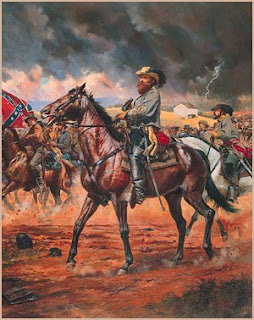 Full Name: James Ewell Brown Stuart
Full Name: James Ewell Brown StuartPosition: Cavalry General in the Confederate States Army
Bio:
Stuart had a mastery of reconnaissance and a great knowledge of using cavalry in support of offensive operations. Jeb, as he was often called by friends, was the major cavalry force of the CSA (Confederate States Army). Stuart was the very incarnation of a cavalier. He loved war's panoply and glory and even wore the clothes of one; red-lined gray cape, yellow sash, hat cocked to the side with a ostrich plume, and red flower in his lapel. Stuart was eager, undaunted, and brave, but also fun-loving.
"A graduate of West Point Class of 1854, the Virginian saw hard service on the western frontier and by 1861 was one of the most experienced Indian fighters in the Regular Army. Severely wounded in a battle with the Southern Cheyennes, Lieutenant Stuart's gallantry had early brought him to the attention of Robert E. Lee." Stuart also participated in the quelling of John Brown's raid on Harper's Ferry, where he served as Lee's aid in 1859.
Stuart was one of those generals that was all about glory. He enjoyed warfare and believed in fighting for the Southern cause. His thirst for glory and wholehearted confidence in his hard-riding troopers at times led him into perilous situations. Two such situations are Brandy Station and Gettysburg. At Brandy Station, thinking that he could easily cross the Rappahanok and raid the Union troops led to disaster when Union Major General Joseph Hooker interpreted Stuart's prescense and sent a total of 11,000 men, 8,000 of which were cavalrymen, to spoil Stuart's raid. The battle ended up in a draw, but the surprise it had on Stuart and his men put a dent in his reputation. Not only that, but it showed that the Union cavalry was getting better. For the first part of the war, Stuart had taken advantage of the fact that the South had much more experienced cavalrymen and horseflesh. As the war dragged on, the Union started to slowly use better cavalry commanders.
Stuart's next mistake, and perhaps his biggest, came when Lee was moving the Army of Northern Virginia north through the Shenandoah Valley. Though this is disputed by historians, Lee gave orders to Stuart to march north with the army, use part of his force to guard the mountain passes that came before the Patomac, then cross the river and screen the right flank of Ewell's Second Corps. Instead of taking a straight shot near the mountains, Stuart took his three best brigades between the Union troops and Washington D.C., then link up with Ewell's troops. This was in an effort to bypass supplies and cause havoc near the capital. Unfortunately for Stuart, the movement of the Union troops was already underway and the proposed route was now filled with Union soldiers. This forced Stuart farther east than he anticipated and he was unable to link up with Ewell. Thus, Stuart was a little late to the party that was the Battle of Gettysburg. Lee did not have his eyes and ears, which caused a major hindrance on the Confederate troops going into the massive battle. When Stuart finally made it, Lee gave him a rare rebuke, or so it is assumed, since no one else was in the tent with them. This proved to be the defining stain on Stuart's career, and he later became a scapegoat, along with James Longstreet, for the loss at Gettysburg by post-bellum proponents of the Lost Cause Movement.
 Though he had those two marks against him during his career, Stuart proved to be an essential part of the Confederate Army. He was by far the most capable cavalry commander they had and he showed it time and time again. He specialized in circumventing the Union armies and especially Union Cavalry troops. He did it to McClellan's Army on the Virginia Peninsula, then to John Pope's Army of Virginia, and again to McClellan following Antietam. Stuart literally ran circles around the Union army and embarrassed the lousy generals the Union was working with at the time. What also made Stuart a great cavalry commander was his realization that mounted troops were to also act as advanced scouts. His troops gathered information about enemy numbers and troop movements, and relayed vital information to high command. Perhaps Stuart's defining moments was when he made the dangerous march toward the Potomac in June 1863. Although facing a much-improved Yankee cavalry, Stuart repeatedly thwarted his counterpart, General Alfred Pleasonton, when the Union horsemen attempted to locate Lee's northward-marching army.
Though he had those two marks against him during his career, Stuart proved to be an essential part of the Confederate Army. He was by far the most capable cavalry commander they had and he showed it time and time again. He specialized in circumventing the Union armies and especially Union Cavalry troops. He did it to McClellan's Army on the Virginia Peninsula, then to John Pope's Army of Virginia, and again to McClellan following Antietam. Stuart literally ran circles around the Union army and embarrassed the lousy generals the Union was working with at the time. What also made Stuart a great cavalry commander was his realization that mounted troops were to also act as advanced scouts. His troops gathered information about enemy numbers and troop movements, and relayed vital information to high command. Perhaps Stuart's defining moments was when he made the dangerous march toward the Potomac in June 1863. Although facing a much-improved Yankee cavalry, Stuart repeatedly thwarted his counterpart, General Alfred Pleasonton, when the Union horsemen attempted to locate Lee's northward-marching army.Stuart's downfall would come in the form of Major General Phillip Sheridan during the Overland Campaign in 1864. Sheridan guessed that if they focused all their cavalry on a raid against Confederate supplies and railroad lines close to Richmond, they could get Stuart to come out. The battle of Yellow Tavern took place at an abandoned inn located six miles north of Richmond.
"The Confederate troopers tenaciously resisted from the low ridge line bordering the road to Richmond, fighting for over three hours. A counter charge by the 1st Virginia Cavalry pushed the advancing Union troopers back from the hilltop as Stuart, on horseback, shouted encouragement while firing his revolver at the Union troopers. As the 5th Michigan Cavalry streamed in retreat past Stuart, a dismounted Union private, 48-year-old John A. Huff, turned and shot Stuart with his .44-caliber revolver." Huff, a trained sharpshooter, though not armed with a scoped rifle like usual, still had a dead shot and apparently shot Stuart from 40 yards away. Huff ran back to his lines to avoid retribution, as it was still considered a jerk move to shoot commanders. The bullet struck Stuart in the left side, slicing through his stomach and then exited his back. Stuart was taken off the battlefield and died the next day of his wounds, his last words being,"I am resigned; God's will be done."
 Stuart's wife, after his death noted, "He told me he never expected to live through the war, and that if we were conquered, that he did not want to live." His death could not have come at a more opportune time if that were true. The tide had turned in the Union's favor and cavalry generals for the North like Sheridan and Custer were finally getting the better of the Confederate cavalrymen. If he had seen it to the end, Stuart would of been heartbroken. That seems a bit odd today, but there were many men of the Confederacy that didn't want to live unless they were free from the Union. Stuart's death, though not as tragic or costly as Stonewall Jackson's, resonated across the Confederacy. Upon learning of Stuart's death, General Lee is reported to have said that he could hardly keep from weeping at the mere mention of Stuart's name and that Stuart had never given him a bad piece of information.
Stuart's wife, after his death noted, "He told me he never expected to live through the war, and that if we were conquered, that he did not want to live." His death could not have come at a more opportune time if that were true. The tide had turned in the Union's favor and cavalry generals for the North like Sheridan and Custer were finally getting the better of the Confederate cavalrymen. If he had seen it to the end, Stuart would of been heartbroken. That seems a bit odd today, but there were many men of the Confederacy that didn't want to live unless they were free from the Union. Stuart's death, though not as tragic or costly as Stonewall Jackson's, resonated across the Confederacy. Upon learning of Stuart's death, General Lee is reported to have said that he could hardly keep from weeping at the mere mention of Stuart's name and that Stuart had never given him a bad piece of information.Stuart is still considered the one of the best, if not the best cavalry officer that the U.S. has ever created. With his death, Lee lost his trusted "eyes and ears" and the loss further cemented the Confederacy's demise.














